Proudly Serving Our Customers
See All ReviewsStainless Steel Adapters for Every Application

Glacier Tanks offers a complete line of stainless steel adapters for connecting different fitting types, threading styles, and hose setups across sanitary and industrial applications.
Whether you’re building a brewery, scaling up an extraction system, or modifying a cleaning process, our wide selection of adapters ensures compatibility, flexibility, and flow efficiency. Below, you’ll find detailed information on each adapter type, including typical use cases, industry applications, and tips to help you choose the right one.
Camlock Adapters (Cam and Groove)

Overview:
Camlock adapters—also known as cam and groove fittings—offer one of the fastest, tool-free ways to connect hoses or pipes in low- to medium-pressure systems. Simply insert the male adapter into the female coupler and lock it in place using two cam arms.
Common Applications:
- Mobile CIP (clean-in-place) systems in breweries
- Tanker truck loading/unloading
- Temporary hose connections in chemical processing
- Fast-change washdown lines
Example Use Case:
A beverage processor needs to quickly transfer a batch of purée from a tote to a tank. Using camlock adapters on the hose ends allows for secure, fast connections—no tools or clamps needed.
When NOT to Use:
Camlocks are not sanitary fittings. Avoid in systems where direct finished-product contact is required unless downstream sanitization is guaranteed.
Material & Sizes:
304 stainless steel, sizes from 1/2" to 4". Available combinations: tri-clamp x camlock, FNPT x camlock
Pro Tip:
Use dust caps and plugs to keep camlocks clean when not in use.
DIN 11851 Adapters
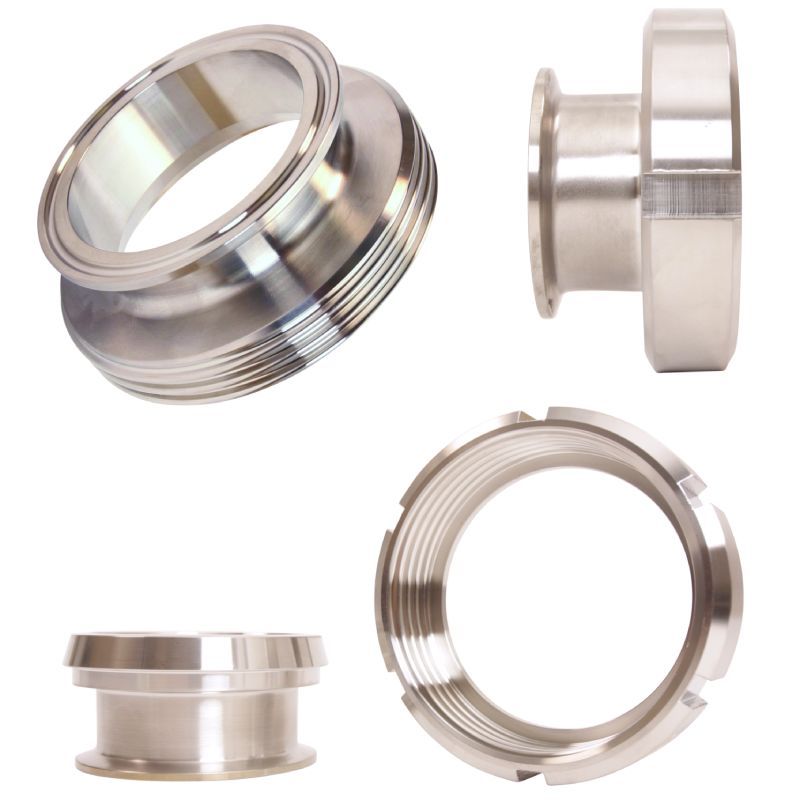
Overview:
DIN(Deutsches Institut fur Normung) 11851 is a standardized sanitary union that is most commonly used in European-designed process systems. These fittings feature a threaded union nut, gasket, and a smooth coupling surface—making them ideal for hygienic, CIP-friendly applications.
Common Applications:
Example Use Case:
You’ve purchased a pasteurizer built in Europe with DIN 11851 ports. A DIN 11851 x tri-clamp adapter allows seamless integration with your existing tri-clamp U.S. sanitary process system.
When to Use:
When you need to connect or adapt European process equipment to North American sanitary systems.
Material & Sizes:
304 stainless steel. Sizes range from DN25 (1") to DN100 (4") equivalents.
Tip:
Identifying DIN parts can be tricky and commonly mistaken for other European sanitary thread types- we have a guide for you here if you are unsure.
FNPT Adapters (Female National Pipe Tapered)
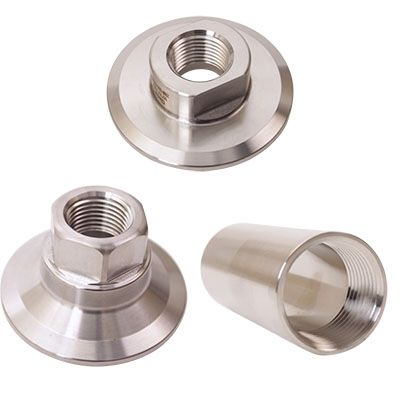
Overview:
FNPT adapters have internal tapered threads and are widely used in U.S. industries. They offer a mechanical seal when paired with Male NPT components and teflon tape or thread sealant.
Common Applications:
- Tank sensors or thermometer wells
- Integrating pipe-threaded valves or gauges
Example Use Case:
Your stainless tank has a tri-clamp port, but your process requires a threaded solenoid valve. A tri-clamp x FNPT adapter bridges the two seamlessly.
When NOT to Use:
Avoid using NPT parts where frequent disassembly is needed or in product contact processes without guaranteed downstream sanitization processes
Material & Sizes:
304/316 stainless steel. Sizes from 1/4" to 4". Combinations include tri-clamp x FNPT, hose barb x FNPT, JIC x FNPT.
FAQ:
Q: Should I use PTFE tape with FNPT threads?
A: Yes — teflon tape or liquid sealant is recommended for a leak-tight seal and to prevent galling with like materials.
MNPT Adapters (Male National Pipe Tapered)
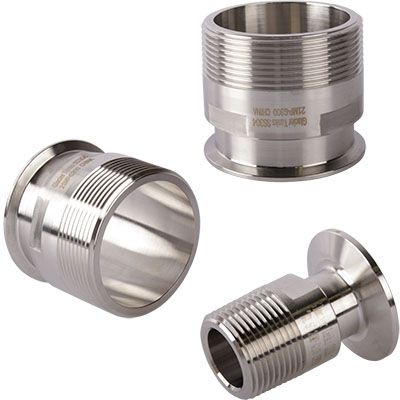
Overview:
MNPT adapters have external tapered threads and are designed to screw into female-threaded systems. These are commonly used for integrating pipes, valves, and regulators in pressure-rated lines.
Common Applications:
- Distillation lines and filter housings
- Any system using NPT-threaded accessories
Example Use Case:
You’re outfitting a glycol chiller with female NPT inlets and want to connect it to a tri-clamp process system. A tri-clamp x MNPT adapter makes the connection clean and secure.
When NOT to Use:
Like FNPT, these threads are not ideal for sanitary contact processes or clean-in-place (CIP) systems.
Material & Sizes:
304 and 316 stainless steel, 1/4" to 4" NPT sizes. Common combinations: tri-clamp x MNPT, hose barb x MNPT, MNPT x JIC
Advice:
Use a thread gauge to confirm if your existing threads are tapered (NPT)before ordering. Check out our threaded fitting guide here: https://www.glaciertanks.com/media/PDFs/ThreadedFittings.pdf
NPS Adapters (National Pipe Straight)
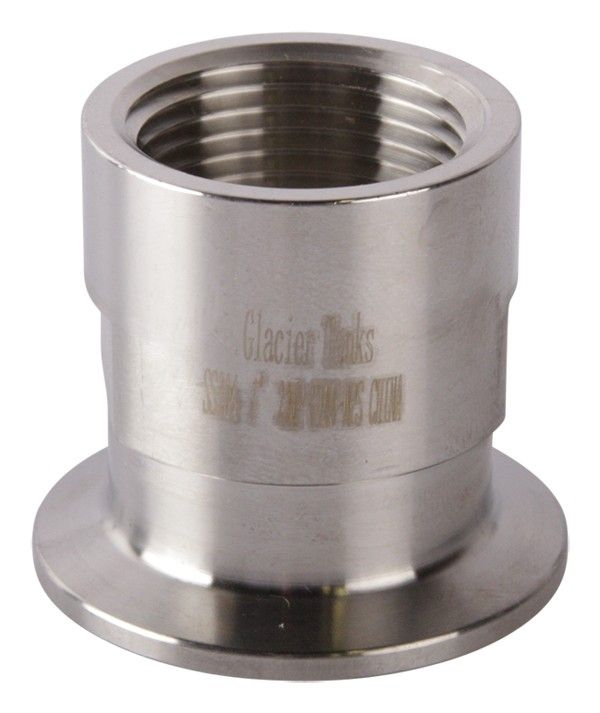
Overview:
NPS adapters have straight threads instead of tapered. NPS require an o-ring in order to seal properly rather than thread engagement like their NPT counterpart.
Common Applications:
- Tank ferrules or bulkhead fittings
- Connecting a threaded piece of equipment (like an electric heating element) to a TC fitting for easy removal and inspection of the equipment
- Adapter points with non-tapered pipe standards
Example Use Case:
You’re retrofitting a tank with a fixed ferrule that has NPS threads. A tri-clamp x NPS adapter allows you to connect the tank to your sanitary process line.
Material & Sizes:
SS304 - Often available in tri-clamp x NPS and male/female NPS configurations.
Tip:
It is important to note that NPS threads look similar to NPT, but they don’t taper. Threading NPT parts to NPS, or vice versa, may permanently damage threads. Always double-check the specs before ordering.
JIC Adapters (Joint Industry Council)
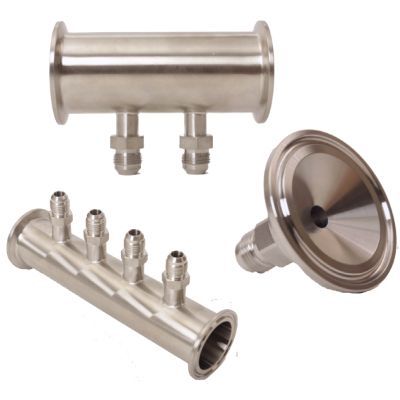
Overview:
JIC adapters feature 37° flare fittings and are widely used in hydraulic and high-pressure applications. The metal-on-metal seal creates a leak-resistant connection capable of operating at high pressures.
Common Applications:
- Extraction labs using pressurized solvents
- Hydraulic hose connections
- CO₂ and gas system integration
Example Use Case:
You’re running a high-pressure ethanol extraction system with flexible PTFE hoses. JIC x MNPT or JIC x tri-clamp adapters allow you to connect hoses safely while maintaining flow control.
Material & Sizes:
Stainless steel JIC adapters typically available in 1/4" to 1/2" sizes. Common combinations include JIC x MNPT and JIC x tri-clamp.
FAQ:
Q: Can JIC be used for sanitary applications?
A: No. JIC fittings are not sanitary. They are designed for pressure and durability, not sanitary processing systems.
NPT Manifolds
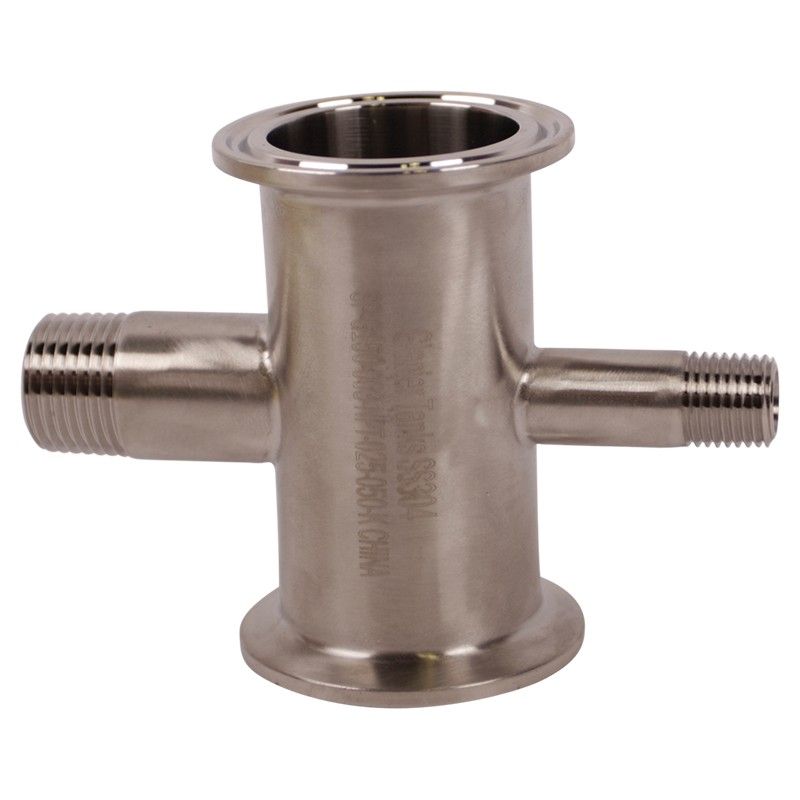
Overview:
NPT manifolds allow multiple threaded ports to branch from a single connection point. These stainless steel manifolds are ideal for distributing air, liquid, or gas to several lines at once—especially in compact or wall-mounted systems.
Common Applications:
Example Use Case:
You’re feeding CO₂ to four jacketed tanks from a single regulator. An NPT manifold with multiple 1/4" FNPT ports enables clean, space-saving distribution.
Material & Sizes:
304 stainless steel. Common configurations:
- 1-inlet x 3-outlet
- 1-inlet x 4-outlet
- FNPT or MNPT ports in 1/4", 3/8", 1/2", 3/4" sizes.
Advice:
Use thread sealant or thread tape on all connections. Add ball valves at each outlet for on/off control and system isolation.
Rubber Hose Adapters (Hose Barbs)
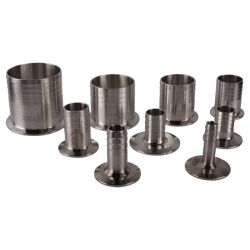
Overview:
Rubber hose adapters, or hose barbs, allow sanitary or industrial systems to connect directly to flexible rubber tubing using a hose barb and clamp configuration.
Common Applications:
- Mobile transfer lines
- Drainage or cleaning lines
- Cold-side brewery or dairy applications
Example Use Case:
A tri-clamp x hose barb adapter lets you quickly connect a 1.5" hose to your tank's CIP port for washdown.
Sizes & Materials:
304/316 stainless. Available in sizes for tubing from 1/4" to 4".
Tip:
Use properly sized clamps, such as Oetiker or worm gear clamps, to prevent leaks or hose slippage. Always measure ID/OD before ordering.
Air Hose Adapters

Overview:
Air hose adapters are designed for compressed air tools or lines and allow integration with tri-clamp or NPT systems.
Common Applications:
- Pneumatic pump control
- Air-driven agitators or diaphragm pumps
- Valve actuation systems
Use Case:
You need to connect a portable air compressor to a tri-clamp-driven pump. A tri-clamp x quick-connect air adapter gets the job done cleanly and quickly.
Material & Sizes:
304 stainless steel, 1.5” and 2” tri-clamp x Industrial Air Hose Quick Disconnect
Note:
Not rated for product-contact applications.
Garden Hose Adapters

Overview:
Garden hose thread (GHT) adapters allow you to hook standard garden hoses into sanitary or industrial process lines. These are great for temporary cleaning or fill tasks.
Common Applications:
- Filling tanks from a hose bib
- Cold-water rinse downs
- Chilling via groundwater
Use Case:
You’re filling a 30-gallon tank for testing with a garden hose. A tri-clamp x GHT adapter makes setup quick and leak-free.
Sizes:
Standard GHT to 1.5” tri-clamp or FNPT available in SS304.
Advice:
Garden hoses are not sanitary. Use only for non-product contact tasks.
Beer Nut Adapters

Overview:
Beer nut adapters are used in draft systems and brewery transfer setups to connect beer lines to keg couplers, faucets, or standard fittings.
Common Applications:
- Draft line cleaning
- Keg-to-line transitions
- Small-batch transfer from serving kegs
Use Case:
You’re cleaning a keg line and want to hook it into a tri-clamp CIP loop. A beer nut x tri-clamp adapter bridges your draft hardware and your cleaning system.
Sizes & Options:
1.5” x Male Beer Nut and 1.5” x Female Beer Nut available in SS304
FAQ:
Q: Are beer nut fittings sanitary?
A: They are commonly used in draft systems, but for high-level sanitation, tri-clamp fittings are preferred.
Why Choose Glacier Tanks?
- Wide inventory of stainless steel adapters in-stock and ready to ship
- All major fitting types and combinations
- High-grade 304 and 316 stainless steel
- Expert support for breweries, labs, and processors
Need help choosing the right adapter? Contact our team or call us—we’re happy to help with compatibility, flow specs, or custom setups.
